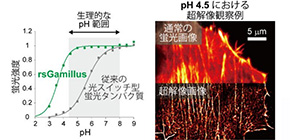
rsGamillus, acid-tolerant green reversibly switchable fluorescent protein, developed
New technique to observe acidic environments inside living cells
A group of researchers from Osaka University developed rsGamillus, an acid-tolerant green Reversibly Switchable Fluorescent Protein (RSFP) that exhibits constant fluorescence emission within the physiological pH range of most normal cells (pH 4.5–9.0). The combination of this RSFP with special microscopic techniques will allow for imaging of living samples with a resolution beyond the optical diffraction limit.
Acidified organelles such as lysosomes (50-1500 nm diameter) are closely related to many vital functions such as autophagy, the process to degrade modified, superfluous or damaged cellular macromolecules and whole organelles. In plants, the cell wall, the major structural component of the extracellular space involved in plant growth, development and metabolism, is kept acidic.
Super-resolution microscopy (SRM), an optical technique that allows for observation of localization and dynamics of biomolecules in living cells with a higher resolution beyond the light diffraction limit (~300 nm), requires (a) a fluorescence tag for observing the biomolecule of interest via a fluorescent marker and (b) super-resolution microscopy techniques that utilize patterned light illumination. SRM is widely-used because protein molecules can be easily tagged with fluorescence proteins (FPs) while minimally interfering with their normal functions. However, since most existing RSFPs lose fluorescence in low pH conditions, FPs had a usage limit for imaging in low pH environments, such as in acidic organelles.
In order to investigate acidic organelle dynamics and minor structure in acidic environments, acid-tolerant green fluorescence proteins were sought after. In 2018, this research group developed an acid-tolerant monomeric green FP (GFP), Gamillus, which exhibits a constant yield of fluorescence in a cellular environment of the fluorescence spectrum between pH4.5 and 9.0, the intracellular range in most cell types, by isolating new fluorescence proteins from glowing tentacles of Olindias formosa (flower hat jellyfish). (Acid-Tolerant Monomeric GFP from Olindias Formosa https://www.sciencedirect.com/science/article/pii/S2451945617304324 )
In this study, by measurement of absorption spectra and X-ray crystallography, the researchers discovered:
- 1. Gamilus exhibited reversible switching between fluorescence on and off states in acidic environments (photoswitching)
- 2. The primary mechanism governing off-switching in green Gamillus was the trans-to-cis isomerization of the chromophore hydroxyphenyl ring that is accompanied by protonation.
Through a combination of rational design and saturation mutagenesis, they developed two variants with enhanced switching contrasts and off-switching speeds: rsGamillus-S and rsGamillus-F. The rsGamillus exhibited photoswitching, i.e., turning on/off of the fluorescent properties of the FP tag.
Existing RSFPs lose fluorescence in low pH conditions (fluorescence p K a ~5–6); however, the rsGamillus variants exhibit superior fluorescence intensity in acidic conditions, which is maintained over the pH range tested. Using single-molecule localization microscopy techniques, rsGamillus can be applied to high-resolution observations in an artificially produced acidic environment of the cell (pH4.5). rsGamillus will become a fundamental technology for discovering unknown life phenomena in acidic environments, making a great contribution to medical study and drug discovery.
Figure 1
Figure 2
The article “Acid-tolerant reversibly switchable green fluorescent protein for super-resolution imaging under acidic conditions” was published in Cell Chemical Biology at DOI: https://doi.org/ 10.1016/j.chembiol.2019.07.012 .
Related links
